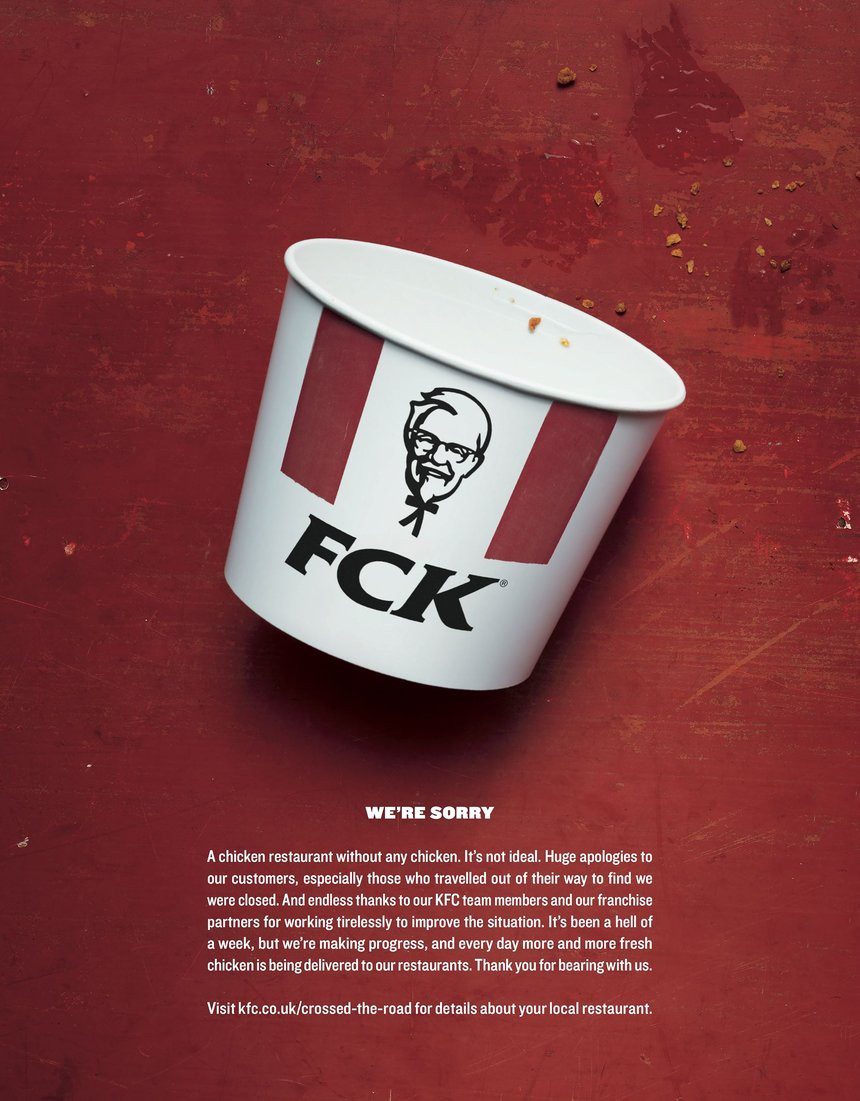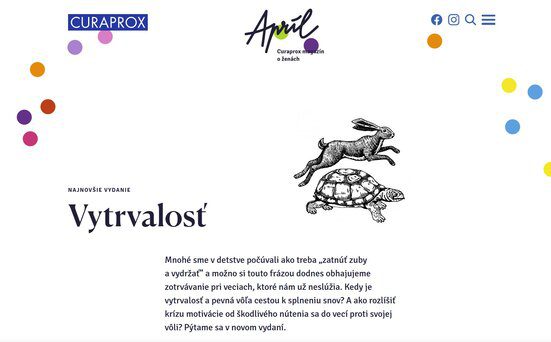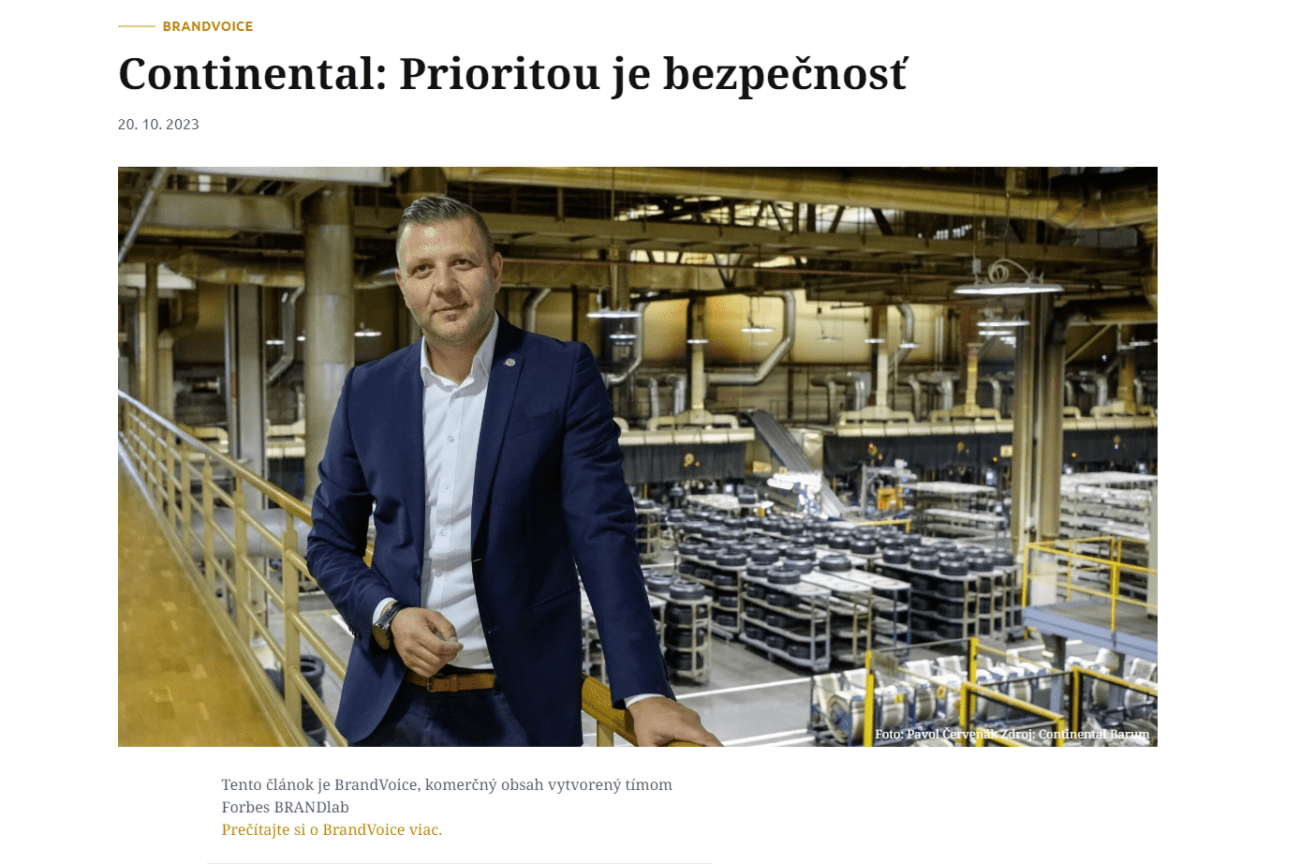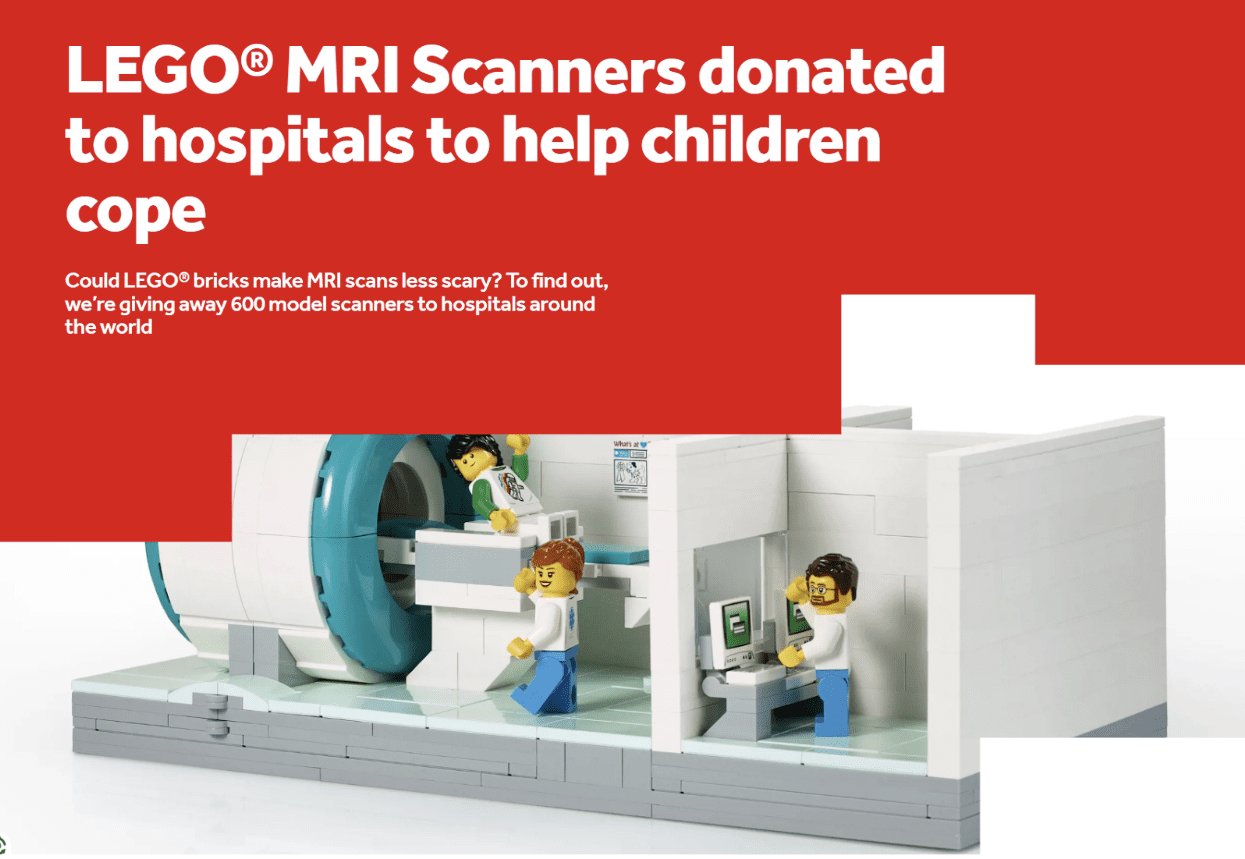What is PR?
The term ‘public relations’ refers to a method of strategic communication, the goal of which is to strengthen the image of the brand and sway public opinion.
The Czech phrase ‘controlled communication’ describes the essence of PR even better than public relations. Do you want to increase the reach of your brand? Are you launching a new product? Are you expanding? Add public relations to your strategy.
What does public relations marketing look like in practice?
The best way to explain PR is with a simple real-life example. In 2018, KFC had to temporarily close hundreds of its establishments due to problems with their meat supply. This was bad news for both customers and the company. KFC decided on an unconventional, but funny, apology.
They changed the letters in the brand name to “FCK” and placed it on a photo of empty packaging with the text “we apologise”.
The PR message appeared in the form of a print advertisement in several British newspapers such as Metro or The Sun, along with an amusing explanation of the situation.

The public relations marketing department of KFC solved the meat supply issue with humour.
The combination of humour and sincerity captured the hearts of customers and people all over the world. Within 48 hours, the “FCK” apology became a viral sensation and was mentioned in nearly 1.2 million social media posts.
They made a mega successful PR campaign out of the absolute failure on the part of their carrier and meat supplier.
Why does a brand need PR?
Maybe you’re not KFC and lack the budget for a similar campaign. But that doesn’t mean you don’t need PR. PR is not a luxury accessory to marketing, but an essential part of it. Both small and large brands need controlled communication with the public. When?
When building a reputation: With the help of PR activities, the brand can communicate its values and attitudes and create added value.
When dealing with crisis situations: When Cristiano Ronaldo removed a Coca Cola bottle from the table during a press conference, a PR crisis intervention strategy immediately came into play.
When building relationships with customers: PR helps build a positive brand reputation and maintain a good name amongst customers.
When gaining trust: The public usually trusts brands that communicate openly and transparently. That’s the role of PR.
When creating media impact: A great PR campaign brings with it positive publicity in the media, which greatly influences brand perception.
How to build a PR strategy
First of all, analyse the situation you are in. How do your customers view you? Is there any media awareness of the brand? Is the image you are creating consistent with the values and direction of the brand?
Find out what influences your brand
- Look out for media mentions.
- Analyse your PR activities to date.
- Re-evaluate your collaboration with influencers.
- Compare the reach of different social media posts.
- Pay attention to how your competition is conducting their PR.
- List external factors that you cannot influence (changing legislation, political and social situation, economy, trends).
Tip: Sometimes a survey among the target group is enough to start a PR campaign.
For example, sales of cosmetics experienced a decline during the pandemic. Brands that wanted to jumpstart sales did a simple survey targeted at women between the ages of 18 and 60. Based on the data, they discovered that women are conducting more and more cosmetic procedures themselves, and so they adjusted PR campaigns accordingly.
They paid for PR articles in various media about topics such as home beauty treatments, hair colouring, advice and tips on how to put on makeup for an online meeting. They tailored the PR campaign to the social situation and based their content marketing on real data.
What makes up a PR campaign?
A PR campaign doesn’t consist only of articles and blogs, but it can also include:
- statements for the media and press releases,
- social media posts and interactions with followers,
- participation in events, conferences and exhibitions,
- collaboration with influencers,
- crisis PR management,
- internal communication with employees,
- employer branding support and so on.
Whatever you do, communicate it through media – both traditional printed media and new, digital options. The method you choose depends on your overall PR and communication strategy.
Own or paid for media?
Public relations are built on a combination of both types, and if you do PR correctly, a third category will also be added – acquired media (those who write about you voluntarily).
You only have control over your own media.
Own media includes any published content that you have full control over. These include blogs, company magazines (for example April, Sóda, Beyond Ecommerce), texts on the web, newsletters and posts on social networks.

Paid media increases brand awareness
It makes no sense to constantly write about yourself on your own media channels. This content has limited reach and less credibility.
When it comes to larger PR campaigns, turn to paid media (paid advertising, PR article, sponsored partnership of various events, etc.) for help.
The best brands are written about by the media themselves.
Brand mentions which are not paid for stand on the highest PR pedestal (positive references, mentions in the media or interviews).
Getting here requires a serious amount of effort and consistent work. But once you become an expert in an area and start appearing regularly in the media related to that topic, you will benefit from sales success, SEO, and overall brand awareness.
The most common form of public relations is PR articles. We’ll guide you on how to write them to make sure they fulfill their purpose.
How to write a PR article
What distinguishes a PR article from any other text is its advertising nature. It wasn’t created just for fun and it plays a role in a whole host of different strategies. In order for readers to transparently distinguish a PR article from other texts, it is marked with a note stating “paid content”, “advertisement”, “PR” and so on.

The key element of any PR article is the headline, which must be interesting but concise. At the same time, it must not mislead the reader and should correspond with the content.
Supplement the content of the article itself with comments from experts and customer reviews and add your own photos. Avoid photobanks and artificially portraying a positive image of the promoted service or product. Exaggerated praise looks suspicious.
If possible, add a dose of storytelling to the PR article.
People love stories and they like to relate to them. Are you writing an article about a hand-crafted candle brand? Add a section about why the company was founded, what the first candle looked like, or why the owner fell in love with candle making.
Structure the text and write in such a way that will be understandable for the target group. Don’t forget to add links and a clear CTA element (Call to Action), for example a button or a link to a specific product.
Examples of great and not-so-great PR campaigns
If you’ve drawn up your strategy, chosen the media and set the goal, it’s time to face the last and most difficult task – the creatives for the PR campaign. Finding a balance between brand insight, customer behavior, trends and social situation is nothing short of an art.
Look for ways to help
In 2022, LEGO delivered 600 LEGO MRI (Magnetic Resonance Imaging) kits to more than 100 hospitals around the world to help children overcome the fear of an unknown examination.
The campaign was a great success because it connected the mission of the Lego brand with the needs of young patients perfectly.

Visual of the extremely successful LEGO MRI PR campaign.
Be funny and unconventional
Iceland invites visitors at visiticeland.com to leave answering their work emails to the Icelandic horses and enjoy their holiday.
Take heed of the social situation
PR campaigns that want to influence a complex social situation in any way are on extremely thin ice, even when it comes to big brands.
When #BlackLivesMatter protests swept across America in 2017, Pepsi released an ad featuring Kendall Jenner. In the middle of the protests, she turns up at the front and hands a uniformed policeman a Pepsi, which seemingly unites everyone.
The ad was immediately subjected to sharp criticism from the general public. When Martin Luther King’s daughter sent a message to Pepsi stating “If only my father knew the power of Pepsi,” it really was time to pull back. Pepsi apologised for the ad.
How can you measure the success of a PR cooperation?
The most common indicator of a successful PR campaign is the number of mentions in the media. You can use the free Google Alerts service to track the number of mentions.
It works on a simple principle. You set keywords that you want to be notified about when they appear on the Internet, in newspaper articles and in blogs. The disadvantage is that it does not collect data from social media.
A more detailed analysis including social media can be obtained via the tools Awario, Alerts by Ahrefs or Mention.
Set measurable PR campaign goals in the preparation phase. Short-term PR campaigns can bring more sales and improve return on investment. In the long term, PR predominantly supports the building of brand awareness and the increase of spontaneous and supported brand knowledge.
Let the world hear about you
Do you need to give your brand a stronger voice? Do you want to expand abroad, but no one knows you there? All this can be solved using a well-thought-out PR campaign.
Get in touch and together we will find a solution that suits your business.







